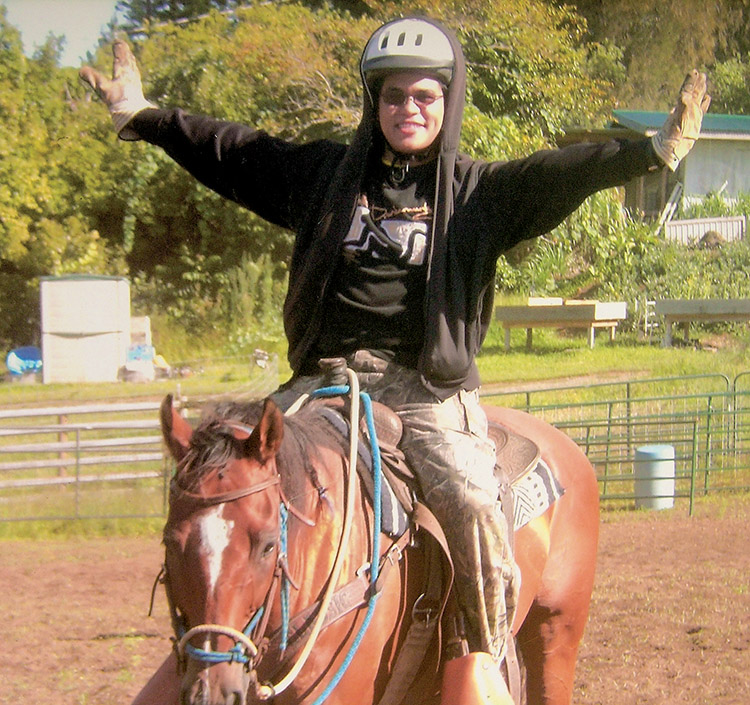
Lighting the Way: Honoka‘a People’s Theatre Ventures into a New Century
 By John J. Boyle
By John J. Boyle
…Long shot from above right, wide shot closes in on the hand painted marquee…
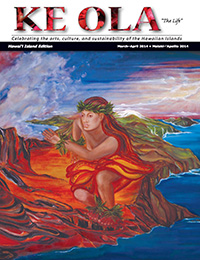
It is 1939, and downtown Mamane street is a walker’s paradise. Soft evening air, light linen shirts and skirts, some kimonos, some cheongsam. Lines forming for the evening’s movie step forward slowly, anxious for the show with talk, whispers, and laughter.
Most had walked in from any one of the three Hāmākua sugar plantation fields: a chop suey of cane cutters, drivers, lunas, land lords, and ladies gather in their finest attire in downtown Honoka‘a for the evening. A few horses and carriages tie up for the night’s movie, traveling from Waipio Valley and as far as Laupāhoehoe.
…Credits rolling…
Cut to newsreel, Honolulu Hawai‘i…
1909, Joel C. Cohen announces in the local papers, “First appearance in Honolulu of the Cameraphone, the machine that sings, dances, and acts.”
He is inviting audiences to the newly refitted Opera House. Originally in storefronts and outdoor walk-in theaters, finally cinema in Hawai‘i moved under a roof. Movie houses sprouted like air-dropped transplants in the Hawaiian Islands.
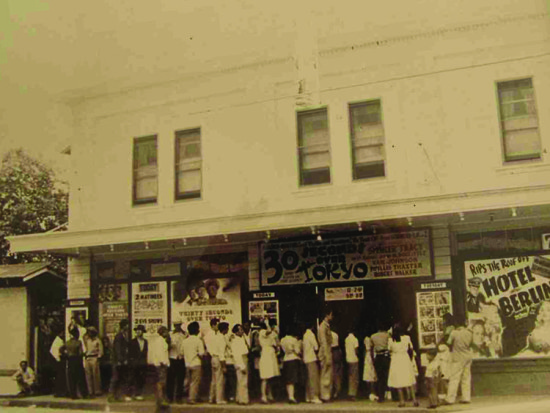
Fade into: flickering sepia black and white over subtitles in English…
In 1930, Honoka‘a was the third largest town in the state after Hilo and Honolulu. The Honoka‘a People’s Theatre began showing films and holding music, dance, and theater events on Mamane Street in downtown Honoka‘a town. This workingman’s theater is one of the finest with an honorable lineage of care and nurture.
In the heyday of Hawai‘i plantations, movie houses brought entertainment to the hard working people of Hāmākua, often a captive audience. Moving pictures traveled across the oceans bringing language and culture to Hawai‘i’s spectrum of immigrants.
Theaters near plantations typically cycled Japanese, Filipino, American films and newsreels. Often it was the only source of news or culture of their home for immigrant workers in the islands.
The Tanimoto family was responsible for building and running several movie houses on the island, including what is now the Aloha Theatre in Kainaliu and what were theaters in Honomū and Mountain View.
Family Fare

It is the legacy of the Tanimoto family that the Keeney Family is carrying on today. Phaethon Keeney remembers Mrs. Peggy Tanimoto fondly, in what were her salad days in town.
“Mrs. Tanimoto occasionally performed in whiteface and costume as a Kamigata-mai—a female Kabuki soloist. She danced hula and was an active and lively community member who performed in talent shows, parades, and bon dances. She was quite gracious and a wonderful lady. I remember her well,” Phaethon shares.
Peggy’s husband, Mr. Christian Tanimoto Sr. ran films until he passed. Then, his good friend, Jiro Kawatachi took over managing; he also ran the sweet shop across street where the Filipino Store is now.
At that time it was operated as a Consolidated Theatre; films would come three to six months after they were released elsewhere.
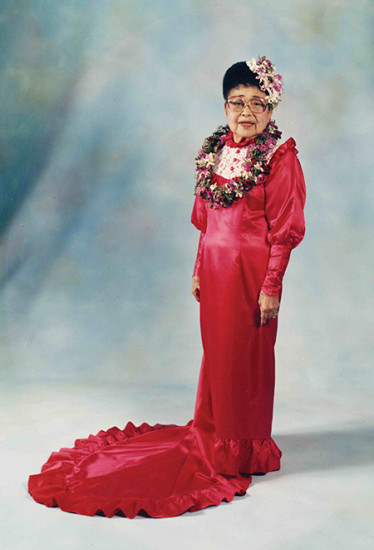
Tawn Keeney, a family doctor in town, took over the lease in 1987, and lived behind the screen, in what was an apartment back then. Yolanda Keeney, took over managing, and the theater was soon an independent theater enterprise with private booking that enabled them to get the films requested sooner.
Cut to 2013 the theater is nearly empty, not dark…
George Santos Jr., projectionist and son of a former master of the magical pyrotechnic wonder called a carbon arc projector, looks up at the large empty screen, side lit with the exit doors emitting beaming afternoon light and remembers.
A slow dissolve to…1978
“Back then, Mrs. Tanimoto had two cats, the rascals, and I had to hunt them down before the movie ‘cause they would brush up against the customers legs in the dark and people would think they were rats.”
He pauses, eyes glistening in memory. “Saturday Night Fever was the best grossing film. It changed Honoka‘a town, playing two times a day for three weeks. The theater was packed every night, every seat up to the front, looking straight up, sore neck, looking at screen; back then, no stage, seats right up to the screen; costs were $1.50 to $1.75 a ticket; the lobby was filled with more than 20 pinball machines, a jukebox, bowling game—we made good money,” George says.
…Hold the Sugar, Cut!
Is there a doctor in the house?
…slowly fade up on fields of overgrown cane, wet and glistening in a morning light under a rainbow…
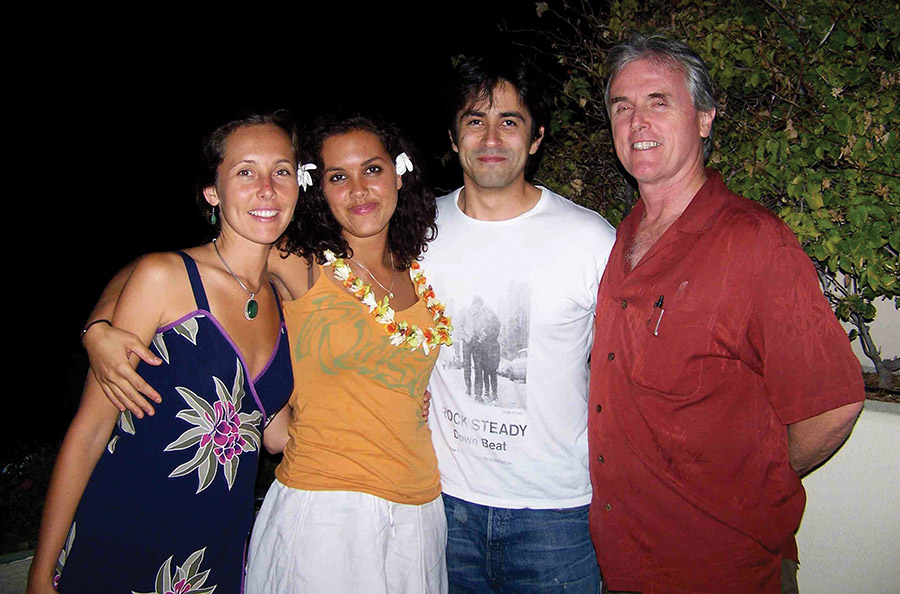
It is the late 1990s, times are hard in Honoka‘a with the closing of the last of Hāmākua’s sugar plantations: an abandoned ranch and cane town is left to its own devices.
With the old screen, poor sound, and the passing of Mrs. Tanimoto, the People’s Theatre closed. Doctor Tawn Keeney purchased the theater he leased, and nursed it back to health. With his family, he repainted the interior on nights and weekends, upgraded the electricity, put in a new screen, projectors, sound system, dance floor, and People’s Theatre reopened in 1992.
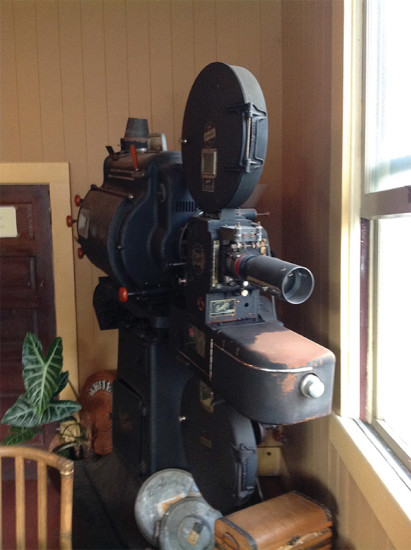 Tawn’s friends, Don Mitts and Jay Sims managed the newly restored theater until 2004 when Phaethon returned from college and found a consolidated partner and husband in Kanoa Withington. Together they took over management and opened the cafe in the front lobby.
Tawn’s friends, Don Mitts and Jay Sims managed the newly restored theater until 2004 when Phaethon returned from college and found a consolidated partner and husband in Kanoa Withington. Together they took over management and opened the cafe in the front lobby.
The growing Keeney family has performed a multitude of tasks to continue bringing the theater up-to-date.
Then came the new millennium of digital projection, omni-media performance and art, and once again, it was recognition of the times, the needs, and the people.
This time it was a full-on restoration, historically, of a relic, carefully saving the best parts and meeting the new technological needs of the next generation. In their loving renovation of the projection booth, apartment, lobby, dressing room, 525 seat theater, and land, the Keeney family have restored The People’s Theatre to its anachronistic beauty, with state-of-the-art upgrades, attention, and care.
Phaethon details the improvements. She says, “We’ve moved the screen back for a larger stage; installed a house sound system for live events, a new video projector to play DVD/Blu-rays for independent films; improved the theater lighting, put in a new roof, added in solar, and have begun programming two shows a day six days a week with touring and local live performances. This has partially been made possible by the installation of new lights and an in-house live sound system that allows us to stage community events at far lower costs to the organizers than anywhere on the island.”
Theater With A Vision
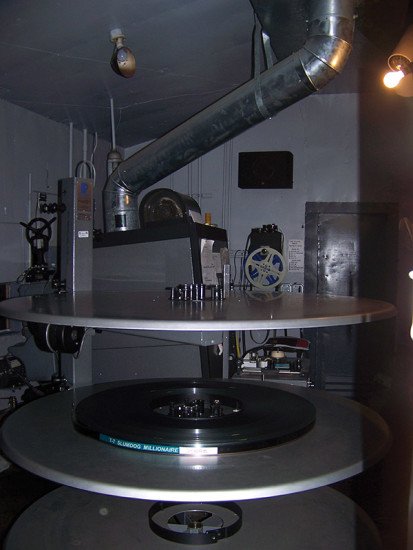 …cut to Saturday night 2014…
…cut to Saturday night 2014…
The five o’clock art film is letting out, and a friendly crowd mills about the cafe with soft drinks and popcorn for the seven o’clock blockbuster. Families and smiling couples stroll into the theater for stories on film and stage. On other days it’s a children’s matinee, or a first run, or a documentary. At other times, People’s Theatre presents live music and a dance floor in the restored music hall designed to serve the people.
Like a well-strung violin with years of polish and human oils, this wonderful theater is back and vitally functioning as a stage, hosting world traveling events in acoustic and visual splendor.
People’s Theatre has been home to the Hamakua Music Festival, Gary Washburn’s excellent Honoka‘a Jazz band, and brings in European, American, and Asian music, film, and art. It was also featured in the film, Honoka‘a Boy.
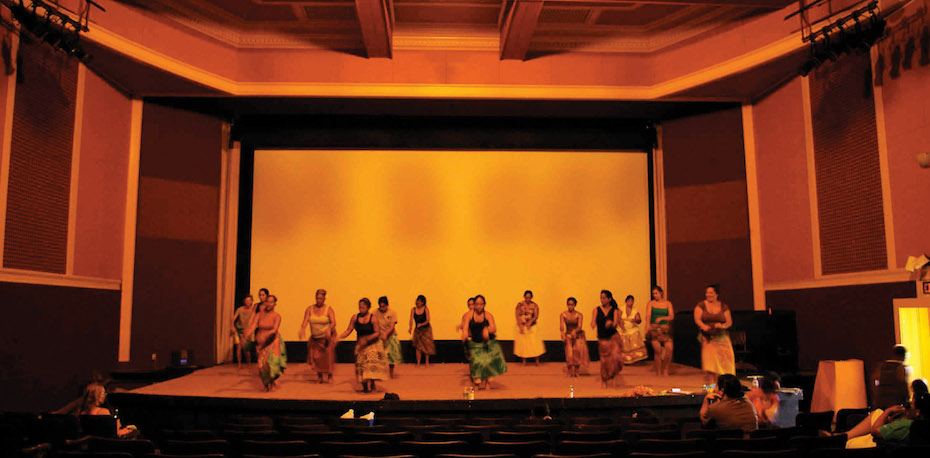
A Theater for the People
People’s Theatre is working on a joint project with North Hawai‘i Research Center along with local merchants to put on a rotating display of photographs and mementos, which assuredly will deepen the appreciation of the rich history of the area.
With a progressively populist vision to promote the rich local stories with drama and hula depicting Hāmākua history from Waipi‘o to the summit of Mauna Kea, People’s Theatre has begun to give the theater back to the people. The “Honoka‘a Community Theatre Group” is currently underway, writing and performing original plays on stage. The dance floor is graced with dance classes in modern, tango, butoh, and a hula hālau of more than 50 members. Again, the theater is open to Hāmākua coasts needs in sponsoring various public fundraisers and events.
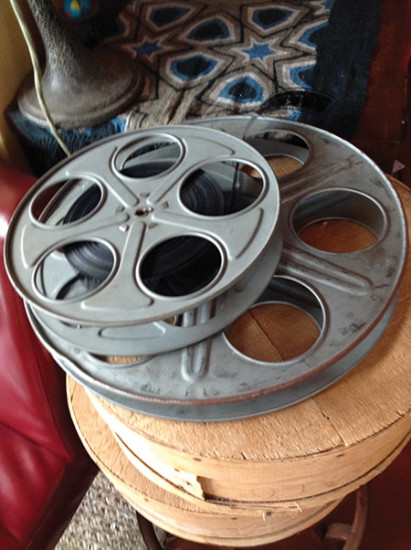 Phaethon shares, “The theater is a family business and a hub for the community, yet the income from business does not cover the costs of keeping the building open, yet. We’d like to continue offering the theater to the community, so we see the need to open the theater to a nonprofit that will guide the use of the space in creating events and activities to benefit the community. This includes selecting films, hosting meetings and lectures, as well as classes in the performing arts, film, live events and cultural shows.”
Phaethon shares, “The theater is a family business and a hub for the community, yet the income from business does not cover the costs of keeping the building open, yet. We’d like to continue offering the theater to the community, so we see the need to open the theater to a nonprofit that will guide the use of the space in creating events and activities to benefit the community. This includes selecting films, hosting meetings and lectures, as well as classes in the performing arts, film, live events and cultural shows.”
A nonprofit will also be helpful answering the question of what to do about the movie industry changing from 35 mm film to digital format.
“We’re still brainstorming but are open to suggestions in how to keep the theater from going dark. We welcome input from the community and would love any help with regards to the formation of a nonprofit and finding ways to serve the people. The theater really lucked out with being in a town like Honoka‘a—it’s the people here who fill the place and make it such a cool place to be. They’re the right mix of people who love country life, nature, family, culture, creative and independent thinking, and a sense of community. The reason that the theater holds on is that the people fill it with their energy and take from it a little bit of each other, and over the years that has amounted to a lot of good times. Lucky we live Hawai‘i!”
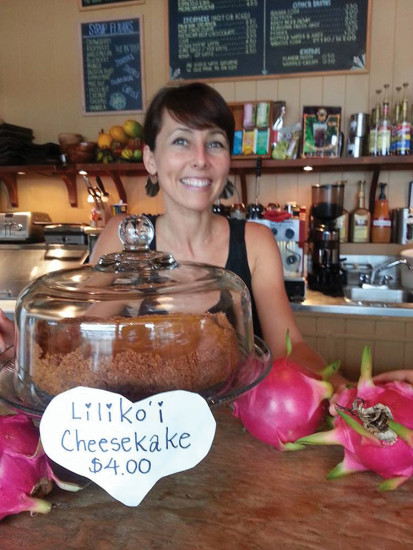 In the last year, they opened a cafe in the lobby serving organic, local Hāmākua coffees, fresh fruit smoothies, salads, and sandwiches on street side tables in addition to the inside lobby. More than just a movie house, it is a place for gathering before and after shows where one can watch a town move by.
In the last year, they opened a cafe in the lobby serving organic, local Hāmākua coffees, fresh fruit smoothies, salads, and sandwiches on street side tables in addition to the inside lobby. More than just a movie house, it is a place for gathering before and after shows where one can watch a town move by.
It is its past, present, and future that is keeping the Honoka‘a People’s Theatre a beacon for art and cultural gathering in and amongst a shrinking screen hand held world.
…house lights at half, credits rolling, slippahs shuffling, whispers, laughter… ❖
Contact Honoka‘a Peoples Theatre: HonokaaPeople.com
North Hawai‘i Research Center: Hilo.Hawaii.Edu/academics/nherc
Contact writer John J. Boyle: jjjboyle2112@gmail.com

